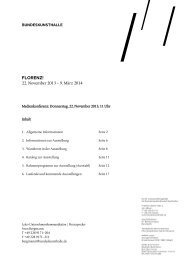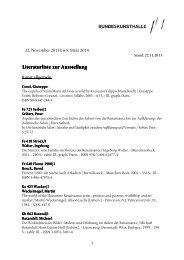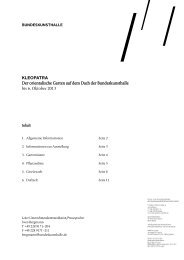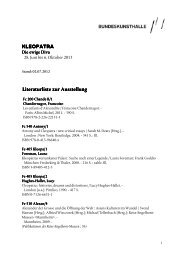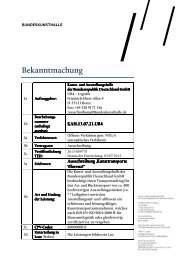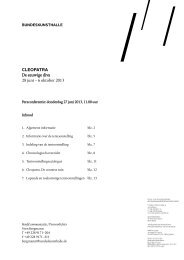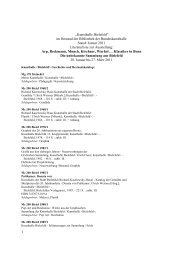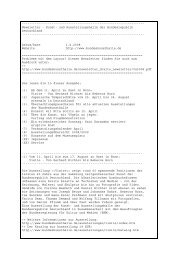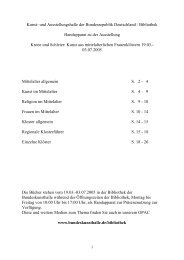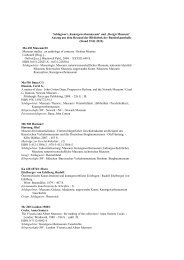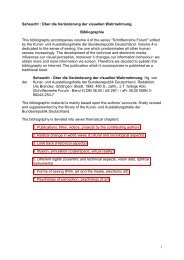Peoples through space and time Archaeology in Germany 09.05 ...
Peoples through space and time Archaeology in Germany 09.05 ...
Peoples through space and time Archaeology in Germany 09.05 ...
You also want an ePaper? Increase the reach of your titles
YUMPU automatically turns print PDFs into web optimized ePapers that Google loves.
To date, more than 250 former ocean plant <strong>and</strong> animal species have been scientifically determ<strong>in</strong>ed. All<br />
of them existed dur<strong>in</strong>g the geological era know as the Lower Devonian Period.<br />
02<br />
Prehistoric Giants<br />
Numerous fossils found <strong>in</strong> <strong>Germany</strong> have long s<strong>in</strong>ce become world-famous: for example the primeval<br />
bird Archaeopteryx, or Solnhofen limestone or Budenbach slate, <strong>and</strong> f<strong>in</strong>ally the ancestral horse found at<br />
the Messel excavation site.<br />
What is little known, however, is that genu<strong>in</strong>e prehistoric giants also existed <strong>in</strong> <strong>Germany</strong>. Impressive<br />
examples of this are the bone rema<strong>in</strong>s of a 160-million-year-old carnivorous predatory d<strong>in</strong>osaur, an<br />
enormous ocean ammonoid that lived 80 million years ago dur<strong>in</strong>g the Cretaceous period, or the<br />
fossilized skeleton of a 10-million-year-old baleen whale measur<strong>in</strong>g 6,50 meters <strong>in</strong> length.<br />
03<br />
The Messel World Natural Heritage<br />
S<strong>in</strong>ce 1995 the Messel fossil pit has become <strong>Germany</strong>’s only Unesco World Natural Heritage site <strong>and</strong> is<br />
of particularly great importance for underst<strong>and</strong><strong>in</strong>g how modern mammals developed. In the 1980s, the<br />
Messel pit was still scheduled to be filled <strong>in</strong> as a waste disposal site.<br />
The fossils were created 49 million years ago <strong>through</strong> sedimentation <strong>in</strong> a volcanic lake. The Messel oil<br />
shale conta<strong>in</strong>s a wealth of unique traces of animal <strong>and</strong> plants that once thrived <strong>in</strong> a lush primeval forest<br />
with an almost tropical climate.<br />
The excellent preservation conditions exist<strong>in</strong>g at the Messel site, result<strong>in</strong>g even <strong>in</strong> the conservation of<br />
stomach contents <strong>and</strong> ‘sk<strong>in</strong> shadows’, made a detailed reconstruction of the appearance <strong>and</strong> lifestyle of<br />
this diverse animal world possible. Research at the pit has as yet not been completely f<strong>in</strong>ished. As a<br />
result, research can expect to uncover more surprises.<br />
04<br />
Ne<strong>and</strong>erthal Man - Our Ancestor?<br />
Archaeological <strong>and</strong> anthropological research is be<strong>in</strong>g carried around the world to determ<strong>in</strong>e the<br />
Ne<strong>and</strong>erthal’s phenotype, his material <strong>and</strong> <strong>in</strong>tellectual capacities as well his environment <strong>and</strong> survival<br />
strategies. S<strong>in</strong>ce this first skeletal rema<strong>in</strong>s were found <strong>in</strong> the Ne<strong>and</strong>er Vally near Düsseldorf <strong>in</strong> 1856,<br />
approximately 300 other rema<strong>in</strong>s of <strong>in</strong>dividuals have been found <strong>in</strong> Europe <strong>and</strong> western Asia.<br />
The Ne<strong>and</strong>erthal with his characteristic skeletal structure emerged 200,000 ago <strong>and</strong> became ext<strong>in</strong>ct<br />
about 30,000 years ago. The evolution <strong>and</strong> demise of this human species are the object of much<br />
controversy <strong>in</strong> the scientific world.<br />
The controversy <strong>in</strong>volves whether the Ne<strong>and</strong>erthals were capable of the k<strong>in</strong>d of language that modern<br />
man has, <strong>and</strong> <strong>in</strong> what relationship they st<strong>and</strong> to Homo sapiens, who appeared approximately 40,000<br />
years ago <strong>in</strong> Europe. Did they mix, or could the Ne<strong>and</strong>erthals have died out without leav<strong>in</strong>g traces <strong>in</strong> the<br />
genetic make-up of modern Homo sapiens, even though they must have existed side-by-side for<br />
thous<strong>and</strong>s of years?<br />
Eye to Eye with a Ne<strong>and</strong>erthal<br />
As soon as the first Ne<strong>and</strong>erthal skeleton was found <strong>in</strong> 1856 first attempts were made to reconstruct his<br />
appearance. Popular images produced <strong>in</strong> the 19 th century of a not-quite upright figure with an<br />
underdeveloped <strong>in</strong>tellect still prevail today.<br />
Yet modern research has been able to develop a totally different picture: an <strong>in</strong>telligent be<strong>in</strong>g perfectly<br />
adapted to his environment, possess<strong>in</strong>g an appearance that is little different from our own.<br />
This is most remarkably demonstrated by recent 3-dimensional reconstructions which have recreated the<br />
skull’s soft tissue. To do this, all data available on <strong>in</strong>dividual characteristics were used. However, the<br />
only comparative data available to us is that of modern man.<br />
The Ne<strong>and</strong>erthal <strong>in</strong> a Genetic Laboratory<br />
Modern technology allows us to extract small samples of DNA from the rema<strong>in</strong>s of persons who died<br />
ages ago. In this process it is important to extract the mitochondria which are responsible for cell<br />
metabolism. Mitochondria DNA, which is <strong>in</strong>dependent from that of the cell core, can only be <strong>in</strong>herited<br />
6




